5.9.1: Kingdom Plantae - Evolution and Phylogeny
- Page ID
- 105417
Kingdom Plantae - Evolution and Phylogeny
- Please read and watch the following Learning Resources
- Reading the material for understanding, and taking notes during videos, will take approximately 90 minutes.
- Optional Activities are embedded.
- Bolded terms are located at the end of the unit in the Glossary. There is also a Unit Summary at the end of the Unit.
- To navigate to Unit 3.4.8, use the Contents menu at the top of the page OR the right arrow on the side of the page.
- If on a mobile device, use the Contents menu at the top of the page OR the links at the bottom of the page.
Learning Objectives
- Identify the challenges to life on land for plants
- Describe the timeline of plant evolution and the impact of land plants on other living things
- Identify the main characteristics of bryophytes
- Identify the new traits that first appear in pterophytes
- Describe the type of seeds produced by gymnosperms, as well as other characteristics of gymnosperms
- State which period saw the first appearance of gymnosperms and explain when they were the dominant plant life
- List the four groups of modern-day gymnosperms and provide examples of each
- Explain why angiosperms are the dominant form of plant life in most terrestrial ecosystems
- Describe the two main groups of flowering plants
Introduction
The kingdom Plantae constitutes large and varied groups of organisms. All are eukaryotic, multicellular with differentiated tissues, and photosynthetic. There are more than 300,000 species of cataloged plants. Of these, more than 260,000 are seed plants. Mosses, ferns, conifers, and flowering plants are all members of the plant kingdom.
Evolutionary History of Plants
The major event to mark the Ordovician, more than 500 Ma, was the colonization of land by the ancestors of modern land plants. Fossilized cells, cuticles, and spores of early land plants have been dated as far back as the Ordovician period in the early Paleozoic era. The oldest-known vascular plants have been identified in deposits from the Devonian. One of the richest sources of information is the Rhynie chert, a sedimentary rock deposit found in Rhynie, Scotland, where embedded fossils of some of the earliest vascular plants have been identified (Figure \(\PageIndex{1}\)).

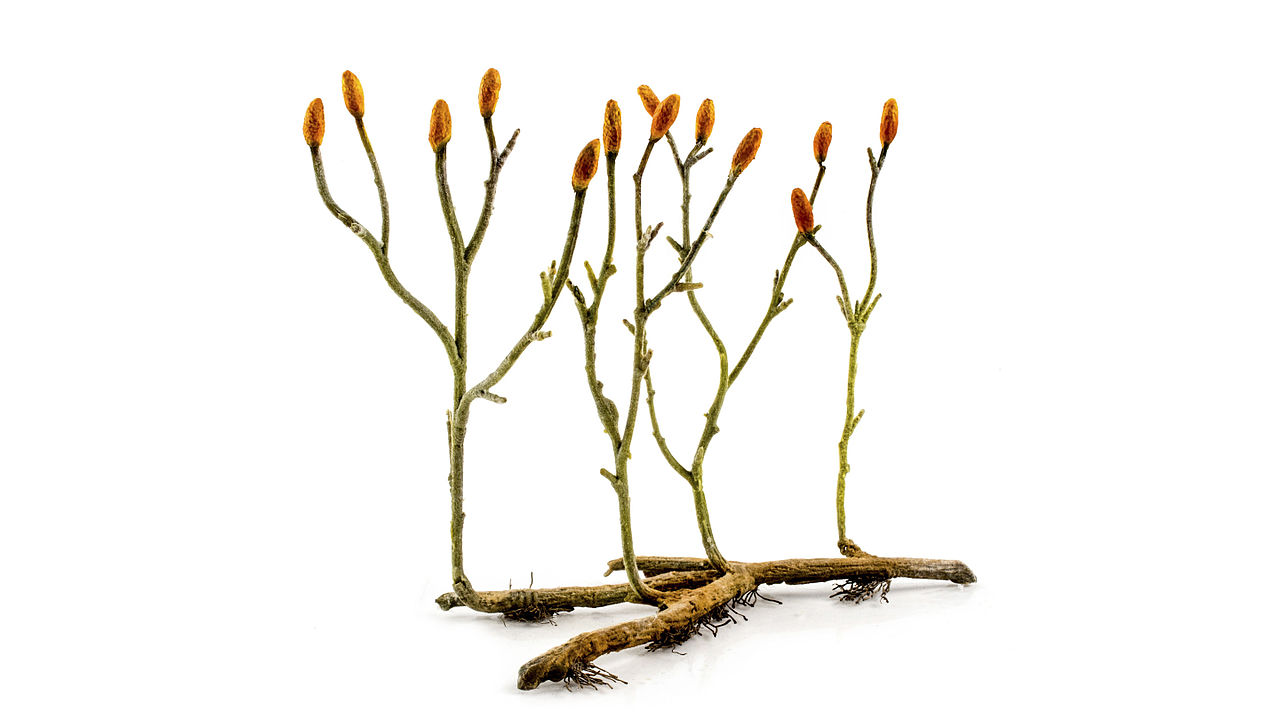
Current evolutionary thought holds that green algae and land-dwelling plants are monophyletic. The evolutionary transition from water to land imposed severe constraints on plants. They had to develop strategies to avoid dehydration, disperse reproductive cells, support themselves without water, and capture and filter sunlight. These adaptations were required for the colonization of land begun by the bryophytes (seedless, non-vascular plants) and their ancestors. While seed plants developed adaptations that allowed them to populate even arid habitats, full independence from water did not happen in all plants. Most seedless plants still require a moist environment.
An incredible variety of seedless plants populates the terrestrial landscape (Figure \(\PageIndex{2}\)). Mosses may grow on a tree trunk, and horsetails may display their jointed stems and spindly leaves across the forest floor. Ferns dominate some forest floors. Today, seedless plants represent only a small fraction of the plants in our environment; yet, three hundred million years ago, seedless plants dominated the landscape and grew in the enormous swampy forests of the Carboniferous period. Their decomposition created large deposits of coal that we mine today.
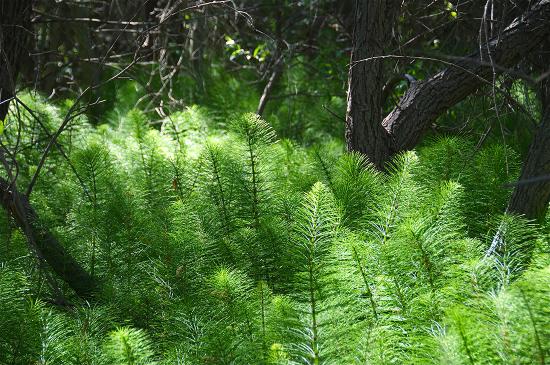
Seeds and pollen, two critical adaptations, distinguish the seed plants from other (seedless) vascular plants. Seed plants, such as conifers and flowering plants, do not rely on water for reproduction like the seedless plants do (Figure \(\PageIndex{3}\)). They play an integral role in all aspects of life on the planet, shaping the physical terrain, influencing the climate, and maintaining life as we know it.
Fossils place the earliest distinct seed plants at about 350 Ma. The first reliable record of gymnosperms (the cone-bearing plants) dates their appearance to the Pennsylvanian period, about 319 Ma. Gymnosperms dominated the landscape in the early (Triassic) and middle (Jurassic) Mesozoic era. Angiosperms (the flowering plants) surpassed gymnosperms by the middle of the Cretaceous (about 100 Ma) in the late Mesozoic era, and today are the most abundant plant group in most terrestrial biomes.

The Major Divisions (i.e. Phyla) of Land Plants
The green algae and land plants are grouped together into a subphylum called the Streptophytina, and thus are called Streptophytes. In a further division, land plants are classified into two major groups (knowns as Divisions rather than phyla) according to the absence or presence of vascular tissue, as detailed in Figures \(\PageIndex{4}\).
Plants that lack vascular tissue (the bryophytes), which is formed of specialized cells for the transport of water and nutrients, are referred to as non-vascular plants. Liverworts, mosses, and hornworts are seedless, non-vascular plants that likely appeared early in land plant evolution. Vascular plants developed a network of cells that conduct water and solutes.
The first vascular plants (the tracheophytes) appeared in the late Ordovician and were probably similar to lycophytes, which include club mosses (not to be confused with the mosses) and the pterophytes (ferns, horsetails, and whisk ferns). Lycophytes and pterophytes are referred to as seedless vascular plants, because they do not produce seeds.
The seed plants, or spermatophytes, form the largest group of all existing plants, and hence dominate the landscape. Seed plants include gymnosperms, most notably conifers, which produce “naked seeds,” and the most successful of all plants, the angiosperms, which produce flowers. Angiosperms protect their seeds inside chambers at the center of a flower; the walls of the chamber later develop into a fruit.
The evolutionary history of the development of each of these groups is detailed in the cladogram in Figure \(\PageIndex{5}\). Each taxa is described in more detail below.

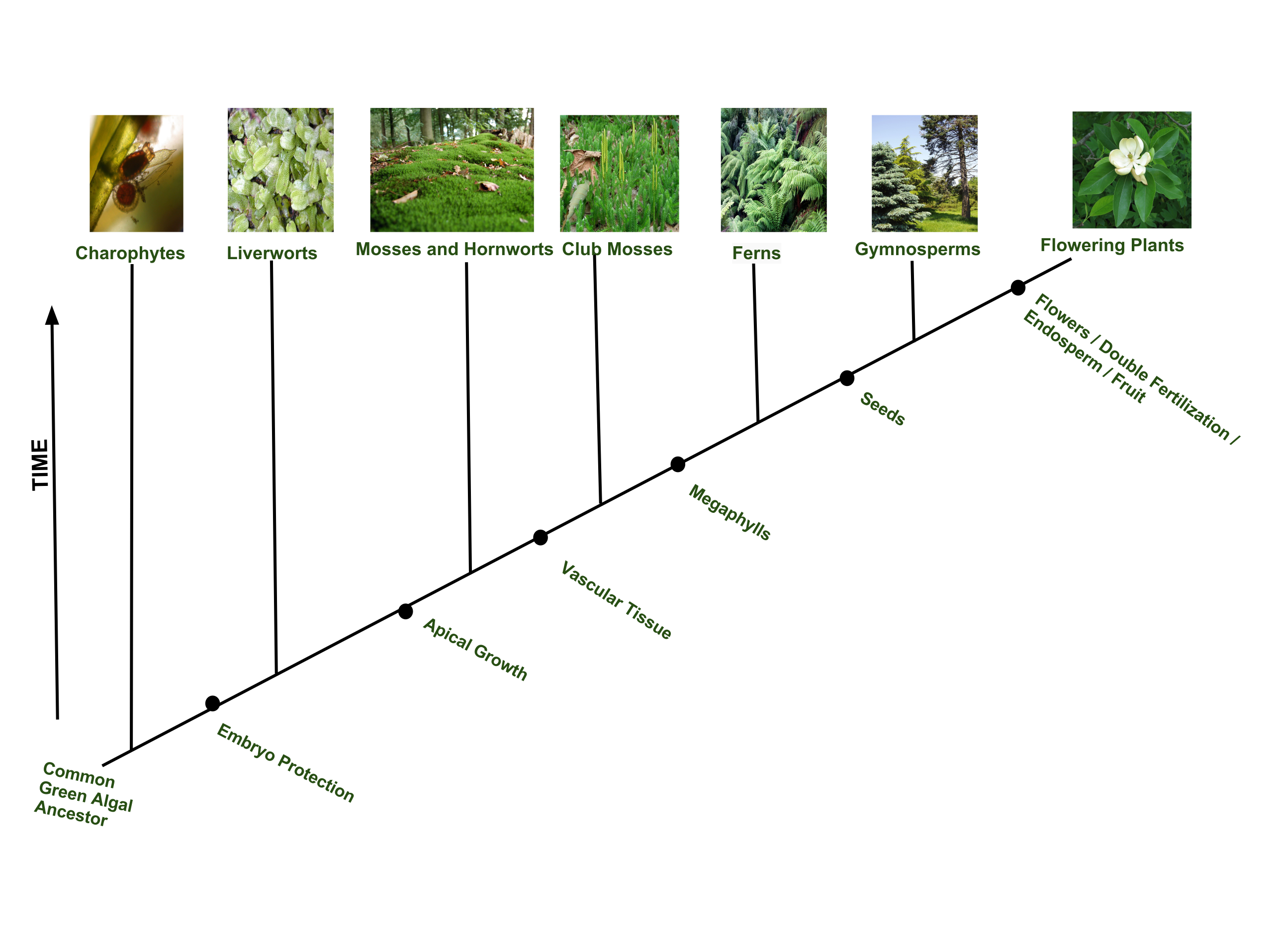 Figure \(\PageIndex{5}\): Evolutionary history of the kingdom Plantae. Laurenprue216; CC-BY-SA 3.0
Figure \(\PageIndex{5}\): Evolutionary history of the kingdom Plantae. Laurenprue216; CC-BY-SA 3.0 Figure \(\PageIndex{4}\): Which of the following statements about plant divisions is false?
- Lycophytes and pterophytes are seedless vascular plants.
- All vascular plants produce seeds.
- All nonvascular embryophytes are bryophytes.
- Seed plants include angiosperms and gymnosperms.
- Answer
-
B.
Evolution Connection: Algae and Evolutionary Paths to Photosynthesis
Some scientists consider all algae to be plants, while others assert that only the Charophytes belong in the kingdom Plantae. These divergent opinions are related to the different evolutionary paths to photosynthesis selected for in different types of algae. While all algae are photosynthetic—that is, they contain some form of a chloroplast—they did not all become photosynthetic via the same path.
The ancestors to the green algae became photosynthetic by engulfing, but not metabolising, a green, photosynthetic bacterium about 1.65 billion years ago. That algal line evolved into the Charophytes, and eventually into the modern mosses, ferns, gymnosperms, and angiosperms. Their evolutionary trajectory was relatively straight and monophyletic. In contrast, the other algae—red, brown, golden, stramenopiles, and so on—all became photosynthetic by secondary, or even tertiary, endosymbiotic events; that is, they endosymbiosed cells that had already endosymbiosed a cyanobacterium. These latecomers to photosynthesis are parallels to the Charophytes in terms of autotrophy, but they did not expand to the same extent as the Charophytes, nor did they colonize the land.
The different views on whether all algae are Plantae arise from how these evolutionary paths are viewed. Scientists who solely track evolutionary straight lines, consider only the Charophytes as plants. To biologists who cast a broad net over living things that share a common characteristic (in this case, photosynthetic eukaryotes), all algae are plants.

What evolved first: eukaryotic cells or cells capable of photosynthesis?
- Answer
-
Bacteria capable of photosynthesis (cyanobacteria) evolved first and were engulfed by larger bacterial cells without being degraded. These photosynthetic cells evolved a mutualistic relationship with their hosts and are now known as chloroplasts within some eukaryotic cells.
The Seedless Plants
Bryophytes (Non-Vascular, Seedless Plants)
Bryophytes are the group of plants that are the closest extant relatives of early terrestrial plants. The first bryophytes (liverworts) most likely appeared in the Ordovician period, about 450 million years ago. Because of the lack of lignin and other resistant structures in these plants, the likelihood of bryophytes forming fossils is rather small. By the Silurian period, however, vascular plants had spread through the continents. This compelling fact is used as evidence that non-vascular plants must have preceded the Silurian period.
Today, more than 25,000 species of bryophytes thrive in mostly damp habitats, although some live in deserts. They constitute the major flora of inhospitable environments like the tundra, where their small size and tolerance to desiccation offer distinct advantages. They generally lack lignin and do not have tracheids (xylem cells specialized for forming conduits inside the plant to conduct water). Rather, water and nutrients circulate inside specialized conducting cells. Although the term non-tracheophyte is more accurate, bryophytes are commonly called nonvascular plants.
In a bryophyte, all the conspicuous vegetative organs—including the photosynthetic leaf-like structures, the thallus, stem, and the rhizoid that anchors the plant to its substrate—belong to the haploid organism or gametophyte. The sporophyte (the diploid organism) is barely noticeable. The gametes formed by bryophytes swim with a flagellum, as do gametes in a few of the tracheophytes. The sporangium, the multicellular sexual reproductive structure, is present in bryophytes and absent in the majority of algae. The bryophyte embryo also remains attached to the parent plant, which protects and nourishes it. This is a characteristic of land plants.
Bryophytes may have been successful at the transition from an aquatic habitat to land, but they are still dependent on water for reproduction and absorb moisture and nutrients through the gametophyte surface. The lack of roots for absorbing water and minerals from the soil, as well as a lack of reinforced conducting cells, limits bryophytes to small sizes. Although they may survive in reasonably dry conditions, they cannot reproduce and expand their habitat range in the absence of water.
The bryophytes are divided into three phyla: the liverworts (Marchantiophyta), the hornworts (Anthocerotophyta), and the mosses (Bryophyta).
Learn more about Bryophytes in this 8-minute video.
Questions after watching: How would you recognize a bryophyte next time you go on a hike in the forest? What are their distinctive features? If they have no root system, how do they take in water? What about other nutrients?
Hank introduces us to nonvascular plants - liverworts, hornworts & mosses - which have bizarre features, kooky habits, and unique sex lives. Nonvascular plants inherited their reproductive cycle from algae, but have perfected it to the point where it is now used by all plants in one way or another.
The Seedless Vascular Plants
Hank introduces us to one of the most diverse and important families in the tree of life - the vascular plants. These plants have found tremendous success and their secret is also their defining trait: conductive tissues that can take food and water from one part of a plant to another part.
The vascular plants, or tracheophytes, are the dominant and most conspicuous group of land plants. More than 260,000 species of tracheophytes represent more than 90 percent of Earth’s vegetation. Several evolutionary innovations explain their success and their ability to spread to all habitats. Vascular plants can achieve enormous heights, thus competing successfully for light. Photosynthetic organs become leaves. Pipe-like cells or vascular tissues transport water, minerals, and macromolecules (especially carbohydrates) throughout the organism.
By the late Devonian period, plants had evolved vascular tissue, well-defined leaves, and root systems. With these advantages, plants increased in height and size. During the Carboniferous period, swamp forests of club mosses (Lycopodiophyta) and ferns, horsetails, and whisk ferns (Pteridophyta), with some specimens reaching heights of more than 30 m, covered most of the land. These forests gave rise to the extensive coal deposits that gave the Carboniferous its name.
Water is still required for the fertilization of seedless vascular plants, and most favor a moist environment as the sperm must swim on a layer of moisture to reach the egg. This step in reproduction explains why ferns and their relatives are more abundant in damp environments. Modern-day seedless tracheophytes include club mosses, horsetails, ferns, and whisk ferns. In seedless vascular plants, the diploid sporophyte is the dominant phase of the lifecycle. The gametophyte is now an inconspicuous, but still independent, organism. Throughout plant evolution, there is an evident reversal of roles in the dominant phase of the lifecycle.
Learn more about lycophytes in this 5.5-minute video.
Questions after watching: What's unique about the "plumbing system" of lycophytes? What is the most significant impact that lycophytes have had on our society?
In this 7-minute video, you will learn more about monilophytes (a smaller clade of the Pteridophyta).
Question after watching: How are monilophytes different to the lycophytes you just heard about in the last video?
Gymnosperms
The fossil plant Elkinsia polymorpha, a "seed fern" from the Devonian period, about 400 Ma, is considered the earliest seed plant currently known. Seed ferns produced their seeds along their branches without specialized structures (Figure \(\PageIndex{6}\)). They are the first true seed plants due to structures called cupules that enclose and protect the ovule, the female gametophyte, and associated tissues, which then developed into a seed upon fertilization. Seed plants resembling modern tree ferns became more numerous and diverse in the swamps of the Carboniferous period.
Following the wet Mississippian and Pennsylvanian periods, which were dominated by giant fern trees, the Permian period was dry. This gave a reproductive edge to seed plants, which are better adapted to survive dry spells. The Ginkgoales, a group of gymnosperms with only one surviving species, Gingko biloba, were the first gymnosperms to appear during the lower Jurassic. Gymnosperms expanded in the Mesozoic era (about 240 Ma), supplanting ferns in the landscape, and reaching their greatest diversity during this time. The Jurassic period was as much the age of the cycads (palm-tree-like gymnosperms) as the age of the dinosaurs. Gingkoales and the more familiar conifers also dotted the landscape.
Gymnosperms, meaning “naked seeds,” are a diverse group of seed plants and are paraphyletic. Their characteristics include naked seeds, separate female and male gametes, pollination by wind, and tracheids (which transport water and solutes in the vascular system). Gymnosperm seeds are not enclosed in an ovary; rather, they are exposed on cones or modified leaves. Sporophylls are specialized leaves that produce sporangia. The term strobilus describes a tight arrangement of sporophylls around a central stalk, as seen in cones. Some seeds are enveloped by sporophyte tissues upon maturation.
Modern gymnosperms are classified into four taxa: Coniferophyta (the conifers), Cycadophyta (the cycads), and Ginkgophyta (the ginko) are similar in their production of secondary cambium (cells that generate the vascular system of the trunk or stem and are partially specialized for water transportation) and their pattern of seed development. However, the three phyla are not closely related phylogenetically to each other. Gnetophyta (a group of 70 species of three genera) are considered the closest group to angiosperms because they produce true xylem tissue with vessel elements.
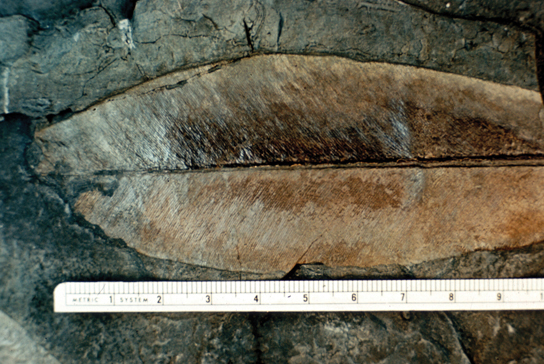
Although angiosperms (flowering plants) are the major form of plant life in most biomes, gymnosperms still dominate some ecosystems, such as the taiga (boreal forests - see Unit 4.4.3) and the alpine forests at higher mountain elevations because of their adaptation to cold temperatures and dry growth conditions (Figure \(\PageIndex{7}\)).

Figure \(\PageIndex{7}\): This boreal forest (taiga) has low-lying plants and conifer trees. Government of Canada: Boreal Forest
Angiosperms (The Flowering Plants)
Undisputed fossil records place the massive appearance and diversification of angiosperms in the middle to late Mesozoic era. Angiosperms (“seed in a vessel”) produce a flower containing male and/or female reproductive structures. Fossil evidence indicates that flowering plants first appeared in the Lower Cretaceous, about 125 million years ago, and were rapidly diversifying by the Middle Cretaceous, about 100 Ma (Figure \(\PageIndex{8}\)). Earlier traces of angiosperms are scarce but fossilized pollen recovered from Jurassic geological material has been attributed to possible angiosperms. A few early Cretaceous rocks show clear imprints of leaves resembling angiosperm leaves. By the mid-Cretaceous, a staggering number of diverse flowering plants crowd the fossil record. The same geological period is also marked by the appearance of many modern groups of insects, including pollinating insects that likely played a key role in ecology and the evolution of flowering plants.
Although several hypotheses have been offered to explain this sudden profusion and variety of flowering plants, none have garnered the consensus of paleobotanists (scientists who study ancient plants). New data in comparative genomics and paleobotany have, however, shed some light on the evolution of angiosperms. Rather than being derived from gymnosperms, angiosperms formed a sister clade that developed in parallel with the gymnosperms. The two innovative structures of flowers and fruit represent an improved reproductive strategy that served to protect the embryo, while increasing genetic variability and range. Paleobotanists debate whether angiosperms evolved from small woody bushes, or were basal angiosperms related to tropical grasses. Both views draw support from cladistics studies, and the so-called woody magnoliid hypothesis, which proposes that the early ancestors of angiosperms were shrubs, also offers molecular biological evidence.
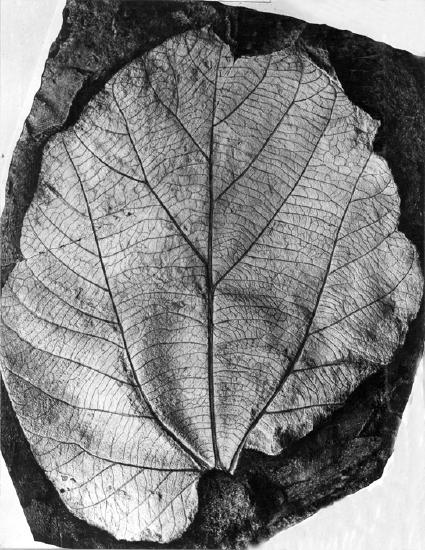
From their humble and still obscure beginning during the early Jurassic period, the angiosperms—or flowering plants—have evolved to dominate most terrestrial ecosystems. With more than 250,000 species, the angiosperm phylum (Anthophyta) is second only to insects in terms of diversification. The success of angiosperms is due to two novel reproductive structures: flowers and fruit (Figure \(\PageIndex{9}\)). The function of the flower is to facilitate pollination, which helps plants mix up their genes with that of other plants to produce offspring. Flowers also provide protection for the ovule and developing embryo inside a receptacle. The function of the fruit is seed dispersal. They also protect the developing seed and assist with germination. Different fruit structures or tissues on fruit—such as sweet flesh, wings, parachutes, or spines that grab—reflect the dispersal strategies that help spread seeds.
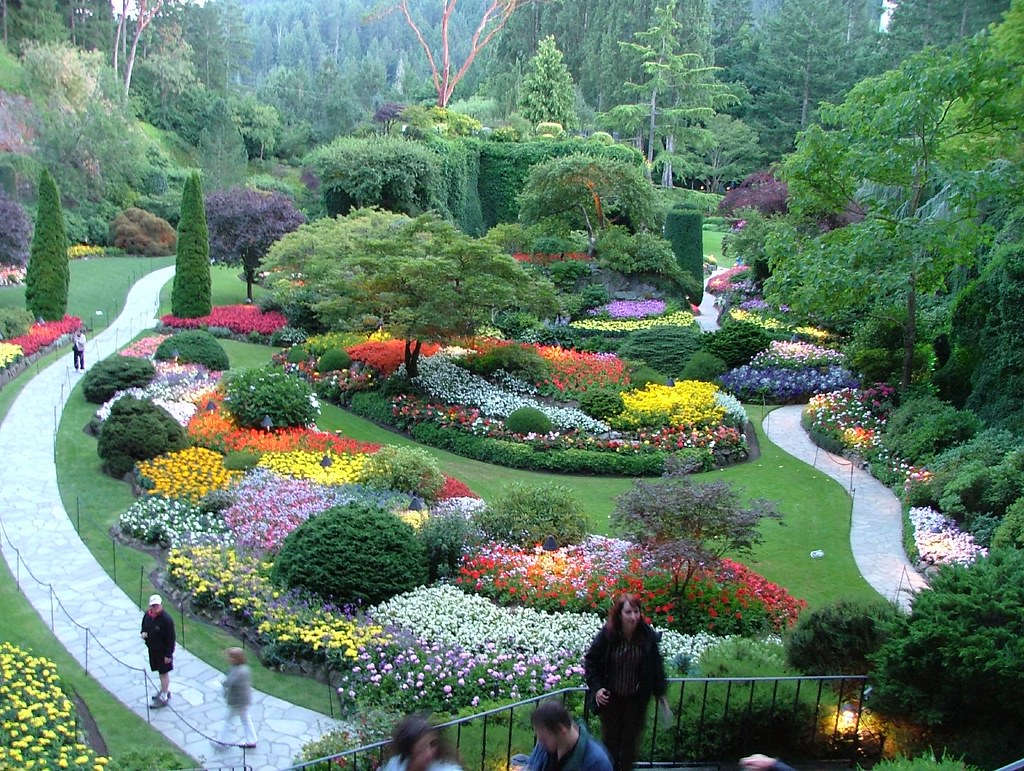 Figure \(\PageIndex{9}\): These flowers grow in the Sunken Gardens at Butchart Gardens in Victoria, BC. Flowering plants dominate terrestrial landscapes. The vivid colors of flowers are an adaptation to pollination by animals such as insects and birds. Jeffrey Beall; CC BY-ND 2.0.
Figure \(\PageIndex{9}\): These flowers grow in the Sunken Gardens at Butchart Gardens in Victoria, BC. Flowering plants dominate terrestrial landscapes. The vivid colors of flowers are an adaptation to pollination by animals such as insects and birds. Jeffrey Beall; CC BY-ND 2.0.Angiosperms are classified in a single phylum: the Anthophyta. Modern angiosperms appear to be a monophyletic group, which means that they originate from a single ancestor. Flowering plants are divided into two major groups, according to the structure of the cotyledons (the first leaves formed after germination), veins (the vascular tissue of xylem and phloem), pollen grains (haploid sperm cells), and other structures such as flower petal numbers (Table \(\PageIndex{1}\)). Monocots include grasses and lilies, and eudicots or dicots form a polyphyletic group. Basal angiosperms are a group of plants that are believed to have branched off before the separation into monocots and eudicots because they exhibit traits from both groups. They are categorized separately in many classification schemes. The Magnoliidae (magnolia trees, laurels, and water lilies) and the Piperaceae (peppers) belong to the basal angiosperm group.
| Characteristic | Monocot | Eudicot |
|---|---|---|
| Cotyledon | One | Two |
| Veins in Leaves | Parallel | Network (branched) |
| Stem Vascular Tissue | Scattered | Arranged in ring pattern |
| Roots | Network of adventitious roots | Tap root with many lateral roots |
| Pollen | Monosulcate | Trisulcate |
| Flower Parts | Three or multiple of three | Four, five, multiple of four or five and whorls |
Marlene Simon interviews Ernesto Sandoval to review the basic features and diversity of Angiosperms.
"Sweetgrass is a fragrant grass with long, satiny leaves. Also known as vanillagrass, mannagrass, and holy grass, it is well known to [some] Indigenous people in Canada and the United States as a material for baskets, as well as a scent, medicine and smudge. Two closely related species are native to Canada: common sweetgrass (Hierochloë hirta subspecies arctica) and alpine sweetgrass (H. alpina). As a widely used and revered sacred plant, sweetgrass is still harvested today, and continues to play an important role in Indigenous cultures.
Sweetgrass is a perennial grass, in the family Poaceae. Usually placed in the genus Hierochloë, it is sometimes included within the genus Anthoxanthum. It has often been treated as one species, Hierochloë odorata, but currently taxonomists recognize up to four species, two of which grow in Canada: common sweetgrass (Hierochloë hirta subspecies arctica) and alpine sweetgrass (H. alpina).
The flat, bright green leaves can grow [more than] half a meter long, and have a distinctively reddish colour at their base. The flowers are small and greenish, and grow in branching clusters at the top of slender, upright stalks. The seeds are small and often infertile, and rarely germinate to create new plants. Sweetgrass’s most common means of reproduction comes from its creeping, underground stems. These stems, known as rhizomes, grow horizontally under the earth, creating dense patches of grass that can be manually divided up to produce new plants.
Sweetgrass thrives in diverse habitats and is circumpolar in distribution. Members of the genus are native to northern Eurasia, Greenland, Iceland, Canada and the United States (except in the south central and southeastern regions). In Canada, common sweetgrass grows near rivers, lake edges, and wet meadows, often forming dense patches, from sea level to subalpine zones. Alpine sweetgrass grows near sea level in the Arctic, and in meadows and on rocky slopes in subalpine and alpine areas in other parts of Canada, especially in the Pacific Coastal and Rocky Mountains."
Adapted from: Turner, N. (2018). Sweetgrass. In The Canadian Encyclopedia. Retrieved from https://www.thecanadianencyclopedia.ca/en/article/sweetgrass

"Sweetgrass" (Matt Lavin; CC BY-SA 2.0)
Thumbnail: Fern plants. (CC BY-SA 3.0; Sanjay ach via Wikimedia Commons).


